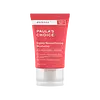Paula's Choice Defense Nightly Reconditioning Moisturizer Versus CeraVe PM Facial Moisturizing Lotion
What's inside
What's inside
 Key Ingredients
Key Ingredients

 Benefits
Benefits

 Concerns
Concerns

 Ingredients Side-by-side
Ingredients Side-by-side

Water
Skin ConditioningGlycerin
HumectantEthylhexyl Palmitate
EmollientHydroxyethyl Acrylate/Sodium Acryloyldimethyl Taurate Copolymer
Emulsion StabilisingIsoamyl Laurate
EmollientPrunus Serotina Fruit Extract
MaskingAlmond/Borage/Linseed/Olive Acids/Glycerides
AntioxidantMedicago Sativa Extract
TonicSesamum Indicum Seed
AbrasiveHydrolyzed Eruca Sativa Leaf
AntioxidantSclerocarya Birrea Seed Oil
HumectantHydrolyzed Algae Extract
Skin ConditioningPalmitoyl Hexapeptide-12
Skin ConditioningPalmitoyl Dipeptide-10
Skin ConditioningSodium Hyaluronate
HumectantCeramide Ng
Skin ConditioningHelianthus Annuus Seed Oil
EmollientCocoyl Proline
Skin ConditioningTocopherol
AntioxidantAllantoin
Skin ConditioningTrehalose
HumectantEclipta Prostrata Extract
Skin ConditioningPotassium Azeloyl Diglycinate
Skin ConditioningOpuntia Ficus-Indica Stem Extract
Skin ConditioningMelia Azadirachta Leaf Extract
Skin ConditioningLeuconostoc/Radish Root Ferment Filtrate
AntimicrobialMoringa Oleifera Seed Oil
EmollientAlaria Esculenta Extract
Skin ProtectingAdenosine Phosphate
Skin ConditioningPEG-10 Phytosterol
EmulsifyingTribehenin
EmollientHydrolyzed Vegetable Protein
Skin ConditioningSorbitan Olivate
EmulsifyingSodium Gluconate
Skin ConditioningZinc Gluconate
Skin ConditioningCopper Gluconate
Skin ConditioningMagnesium Aspartate
Skin ConditioningCetearyl Olivate
Isoamyl Cocoate
Caprylic/Capric Triglyceride
MaskingPolyglyceryl-10 Caprylate/Caprate
EmulsifyingMicrocrystalline Cellulose
AbsorbentC12-15 Alkyl Benzoate
AntimicrobialXanthan Gum
EmulsifyingPentylene Glycol
Skin ConditioningButylene Glycol Stearate
EmollientPhenoxyethanol
PreservativePotassium Sorbate
PreservativeEthylhexylglycerin
Skin ConditioningWater, Glycerin, Ethylhexyl Palmitate, Hydroxyethyl Acrylate/Sodium Acryloyldimethyl Taurate Copolymer, Isoamyl Laurate, Prunus Serotina Fruit Extract, Almond/Borage/Linseed/Olive Acids/Glycerides, Medicago Sativa Extract, Sesamum Indicum Seed, Hydrolyzed Eruca Sativa Leaf, Sclerocarya Birrea Seed Oil, Hydrolyzed Algae Extract, Palmitoyl Hexapeptide-12, Palmitoyl Dipeptide-10, Sodium Hyaluronate, Ceramide Ng, Helianthus Annuus Seed Oil, Cocoyl Proline, Tocopherol, Allantoin, Trehalose, Eclipta Prostrata Extract, Potassium Azeloyl Diglycinate, Opuntia Ficus-Indica Stem Extract, Melia Azadirachta Leaf Extract, Leuconostoc/Radish Root Ferment Filtrate, Moringa Oleifera Seed Oil, Alaria Esculenta Extract, Adenosine Phosphate, PEG-10 Phytosterol, Tribehenin, Hydrolyzed Vegetable Protein, Sorbitan Olivate, Sodium Gluconate, Zinc Gluconate, Copper Gluconate, Magnesium Aspartate, Cetearyl Olivate, Isoamyl Cocoate, Caprylic/Capric Triglyceride, Polyglyceryl-10 Caprylate/Caprate, Microcrystalline Cellulose, C12-15 Alkyl Benzoate, Xanthan Gum, Pentylene Glycol, Butylene Glycol Stearate, Phenoxyethanol, Potassium Sorbate, Ethylhexylglycerin
Water
Skin ConditioningGlycerin
HumectantCaprylic/Capric Triglyceride
MaskingNiacinamide
SmoothingCetearyl Alcohol
EmollientPotassium Phosphate
BufferingCeramide NP
Skin ConditioningCeramide AP
Skin ConditioningCeramide EOP
Skin ConditioningCarbomer
Emulsion StabilisingDimethicone
EmollientCeteareth-20
CleansingBehentrimonium Methosulfate
Sodium Lauroyl Lactylate
EmulsifyingSodium Hyaluronate
HumectantCholesterol
EmollientPhenoxyethanol
PreservativeDisodium EDTA
Dipotassium Phosphate
BufferingCaprylyl Glycol
EmollientPhytosphingosine
Skin ConditioningXanthan Gum
EmulsifyingPolyglyceryl-3 Diisostearate
EmulsifyingEthylhexylglycerin
Skin ConditioningWater, Glycerin, Caprylic/Capric Triglyceride, Niacinamide, Cetearyl Alcohol, Potassium Phosphate, Ceramide NP, Ceramide AP, Ceramide EOP, Carbomer, Dimethicone, Ceteareth-20, Behentrimonium Methosulfate, Sodium Lauroyl Lactylate, Sodium Hyaluronate, Cholesterol, Phenoxyethanol, Disodium EDTA, Dipotassium Phosphate, Caprylyl Glycol, Phytosphingosine, Xanthan Gum, Polyglyceryl-3 Diisostearate, Ethylhexylglycerin
 Reviews
Reviews

Alternatives
Ingredients Explained
These ingredients are found in both products.
Ingredients higher up in an ingredient list are typically present in a larger amount.
This ingredient is an emollient, solvent, and texture enhancer. It is considered a skin-softener by helping the skin prevent moisture loss.
It helps thicken a product's formula and makes it easier to spread by dissolving clumping compounds.
Caprylic Triglyceride is made by combining glycerin with coconut oil, forming a clear liquid.
While there is an assumption Caprylic Triglyceride can clog pores due to it being derived from coconut oil, there is no research supporting this.
Learn more about Caprylic/Capric TriglycerideEthylhexylglycerin (we can't pronounce this either) is commonly used as a preservative and skin softener. It is derived from glyceryl.
You might see Ethylhexylglycerin often paired with other preservatives such as phenoxyethanol. Ethylhexylglycerin has been found to increase the effectiveness of these other preservatives.
Glycerin is already naturally found in your skin. It helps moisturize and protect your skin.
A study from 2016 found glycerin to be more effective as a humectant than AHAs and hyaluronic acid.
As a humectant, it helps the skin stay hydrated by pulling moisture to your skin. The low molecular weight of glycerin allows it to pull moisture into the deeper layers of your skin.
Hydrated skin improves your skin barrier; Your skin barrier helps protect against irritants and bacteria.
Glycerin has also been found to have antimicrobial and antiviral properties. Due to these properties, glycerin is often used in wound and burn treatments.
In cosmetics, glycerin is usually derived from plants such as soybean or palm. However, it can also be sourced from animals, such as tallow or animal fat.
This ingredient is organic, colorless, odorless, and non-toxic.
Glycerin is the name for this ingredient in American English. British English uses Glycerol/Glycerine.
Learn more about GlycerinPhenoxyethanol is a preservative that has germicide, antimicrobial, and aromatic properties. Studies show that phenoxyethanol can prevent microbial growth. By itself, it has a scent that is similar to that of a rose.
It's often used in formulations along with Caprylyl Glycol to preserve the shelf life of products.
Sodium Hyaluronate is hyaluronic acid's salt form. It is commonly derived from the sodium salt of hyaluronic acid.
Like hyaluronic acid, it is great at holding water and acts as a humectant. This makes it a great skin hydrating ingredient.
Sodium Hyaluronate is naturally occurring in our bodies and is mostly found in eye fluid and joints.
These are some other common types of Hyaluronic Acid:
Learn more about Sodium HyaluronateWater. It's the most common cosmetic ingredient of all. You'll usually see it at the top of ingredient lists, meaning that it makes up the largest part of the product.
So why is it so popular? Water most often acts as a solvent - this means that it helps dissolve other ingredients into the formulation.
You'll also recognize water as that liquid we all need to stay alive. If you see this, drink a glass of water. Stay hydrated!
Learn more about WaterXanthan gum is used as a stabilizer and thickener within cosmetic products. It helps give products a sticky, thick feeling - preventing them from being too runny.
On the technical side of things, xanthan gum is a polysaccharide - a combination consisting of multiple sugar molecules bonded together.
Xanthan gum is a pretty common and great ingredient. It is a natural, non-toxic, non-irritating ingredient that is also commonly used in food products.
Learn more about Xanthan Gum